SEO competitor analysis seems like a logical step in the overall SEO tactic. Your website won’t bloom just like that with other competitors around. It’s important to know where your rivals are. More importantly, you should know where YOU are among them.
So, what is SEO competitor analysis? Simply put, it’s a process of discovering various SEO aspects of your rivals. These include their content, backlinks, keywords, and many others. You must be informed of your competition to make the right move.
In our guide about keyword research software, we covered a crucial part of this right move for SEO optimization. Today, we’ll focus on how to perform an SEO competitive analysis, its importance, and a few tools you can use for this purpose.

Why Is SEO Competitor Analysis Vital?
Uncovering your competitors’ strategies and insights is key to success. That much we know. However, an in-depth competitor analysis goes a long way in ensuring long-term goal fulfillment and staying afloat in the ever-growing market.
The end goal is to beat your competition but to do that, you must utilize SEO competitor analysis for these two reasons:
Identifying Your Rivals
If your website is at the top of the totem pole, congrats. You’ve established your presence and know your competition thoroughly. However, if you’re at the bottom, scraping the bottom of the barrel, and trying to go up, you must know who you’re going up against.
This is where an SEO competitor analysis comes into play. It’ll help you find your competitors. These are websites that rank higher than you for the given keyword. Moreover, these sites are in the same niche as yours, thereby, targeting the same audience.
Identifying competition isn’t simple if done manually. On our site, we cover a gamut of products, from VPNs to cloud storage services and hosting providers. Our competitors are not only VPN-related sites but also domains that cover the remaining two niches.
But we can’t just compete against the highest-ranking sites. We need an SEO competitor analysis from Semrush or SE Ranking to see the closest competitors. By beating them, we can move on and climb the ladder. This takes time and patience.
Understanding the Chosen Niche
Another reason to do an SEO competitor analysis is to understand the market you’re targeting. You know who your competitors are but you still don’t know what they offer. You don’t know anything about their content, services, backlink profiles, and keyword optimization.
Worse yet, you don’t know how authoritative these sites are and whether you can compete with them. Using an SEO competitive analysis, you can see if these sites are doing well, which, if yes, indicates that the niche is profitable.
Semrush, for example, offers a plethora of competitive analysis tools to identify backlink/keyword gaps, backlink opportunities, and lost keywords. All of this will dictate your strategy and approach to the competition for long-term prosperity.
Perhaps the best feature of this analysis is the ability to outplay your rivals. You’ll find “holes” in their services and SEO tactics, allowing you to offer something unique they don’t offer, thus, beating them in SERPs and conversions.
How to Conduct an SEO Competitive Analysis?
So, now that we know why an SEO competitor analysis is so important, it’s time to learn more new stuff.
We promised to explain HOW to perform it and there’s no better way of doing that than to use Semrush. Our team prefers Semrush for all SEO tactics.
Do SEO Competitor Analysis With Semrush
In a moment, when we explain all SEO competitor analysis stages, you’ll see why.
Identify Your Competition
Identifying our competition manually is tedious and requires a lot of time. If you’re using Organic Research from Semrush, you’re going to do this in a minute. Open this tool, enter your domain address, and hit Search.
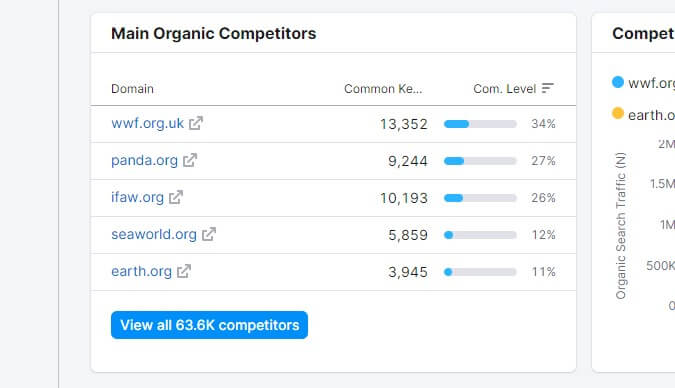
From here, scroll down until you get to the top organic competitors. You’ll see the top 5 and with these websites, you’re competing in Google’s top 20 search results. You can also see all the competitors. In our case, we have 11K+, which is a staggering number.
Semrush will also display your competitors’ paid keywords, competition level, common keywords, traffic, and a few other tidbits.
Check for Authority Scores
Now that you know who your competition is, an SEO competitive analysis goes in another direction – discovering authority scores. Take note of the top 5 or 10 competitors and then go to Domain Overview in Semrush.
Type in the domain address, press search, and right at the top, Semrush will display an authority score of the website. Alternatively, go to Bulk Analysis and type in up to 200 different domains where you’ll see their authority scores, monthly visits, and so forth.
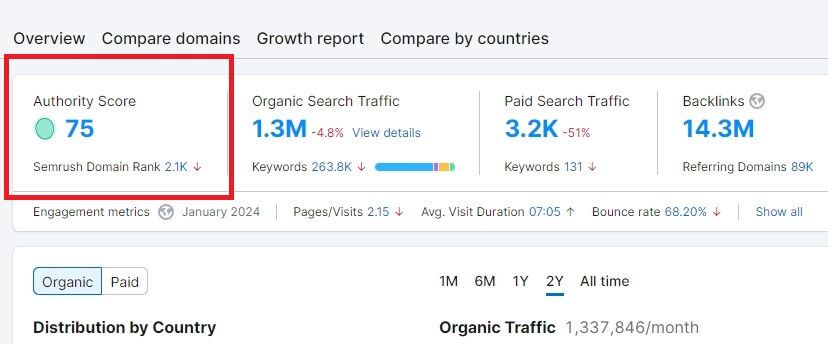
This will allow you to directly compare authority scores and see how you stack up. Why is this important? Look at this as an in-game level. When you’re level 1, you can’t compete with someone who’s level 50 or 70.
If you’ve just started your site, you’ll aim to compete with lower-ranking sites and not those at the top. For this reason, you’ll find an SEO competitor analysis of an authority score crucial. You MUST know where you are to know where to go next.
Detect Keyword Gaps
Finding keyword gaps is another step. It will help you discover the keywords your competitors rank for and your domain doesn’t. As a result, you can optimize your content around these keywords and create new content with them.
Open Keyword Gap in Semrush. First, enter your domain address and then up to 4 others. Click the Compare button and Semrush will come up with the list of keywords. Click on the “Missing” filter, which will display your competitors’ ranking keywords for which you don’t rank.
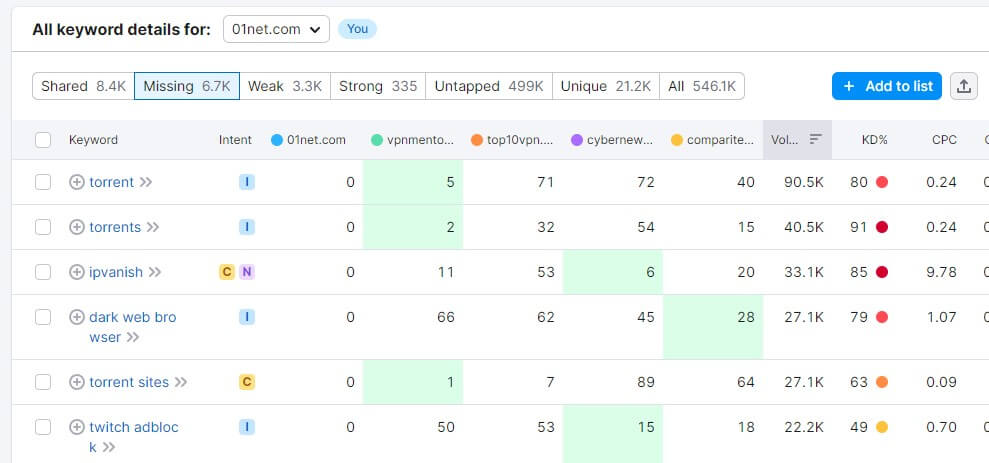
In our case, there are around 1.6K words but of course, you shouldn’t aim to rank for all of them. It would be silly. Instead, find keywords relevant to your site. For example, we found a missing keyword “my io”. This is obviously a mistake – it should be “my IP”.
Therefore, ranking for “my io” is pointless. Find the keywords relevant to your site and use the “Add to List” button at the top to add these keywords to the Keyword Manager in Semrush. You’ll have them ready for when you need them later on.
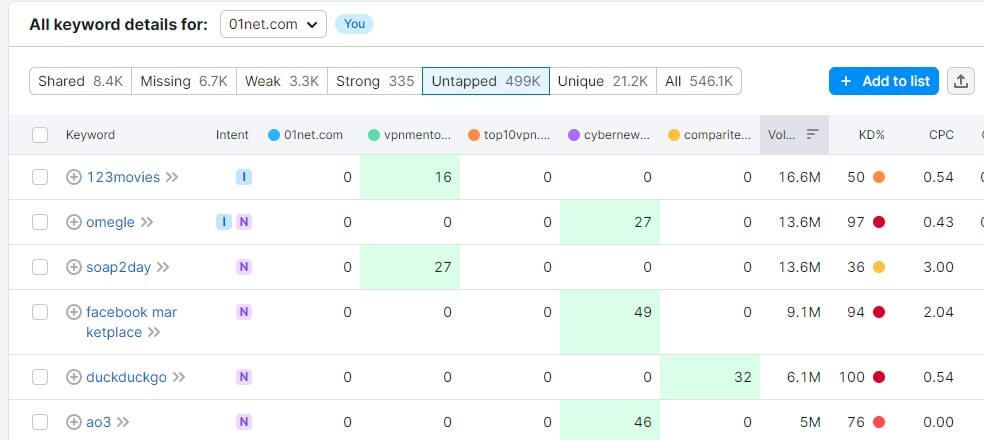
We also recommend checking the Untapped filter in Keyword Gap. Here, you’ll see keywords that at least one competitor ranks for while others don’t. Generally speaking, however, you’ll find almost everything you need in the Missing tab.
Find Lost & New Keywords
Losing a keyword is one of the worst things that could happen to you. It’s when you rank for a specific keyword and then you lose it. However, when that happens to your competitors, you have an opportunity to seize and grab the keyword for yourself!
Again, go to Organic Research and search for the competitor domain. From here, go to Position Changes and scroll down to All Position Changes. You’ll find several filters, one of which is called, again, Position Changes.
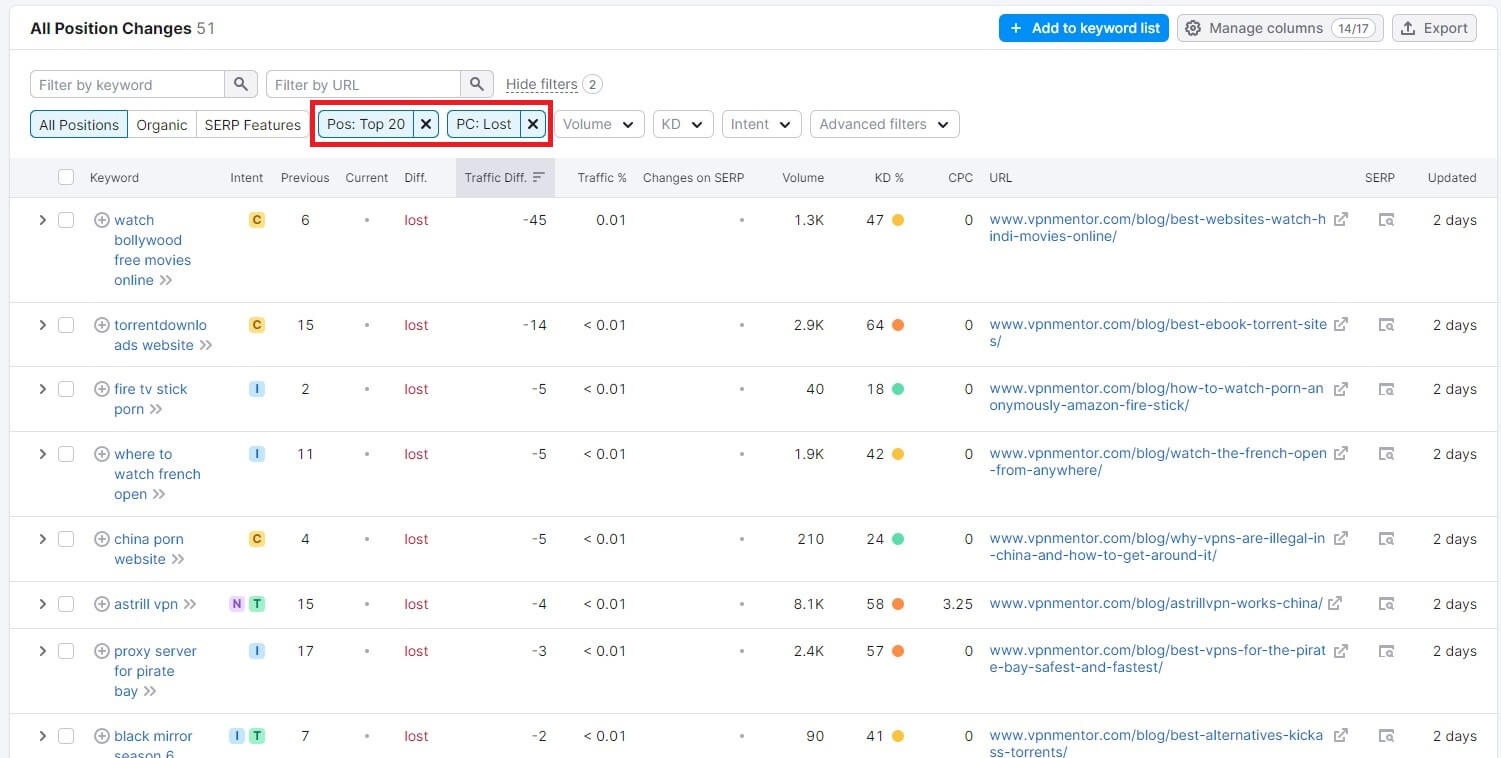
Click on it, and from the drop-down menu, select Lost. Now, click Apply. You should also select Top 20 from the Position drop-down menu left to Position Changes. In our case, Semrush detected four keywords that we can use in our existing or new content.
As a result, we can try and overtake the competitor for these keywords. New keywords are important and indicate the opposite – new phrases that your competitors started to rank for recently. You can discover them the same way.
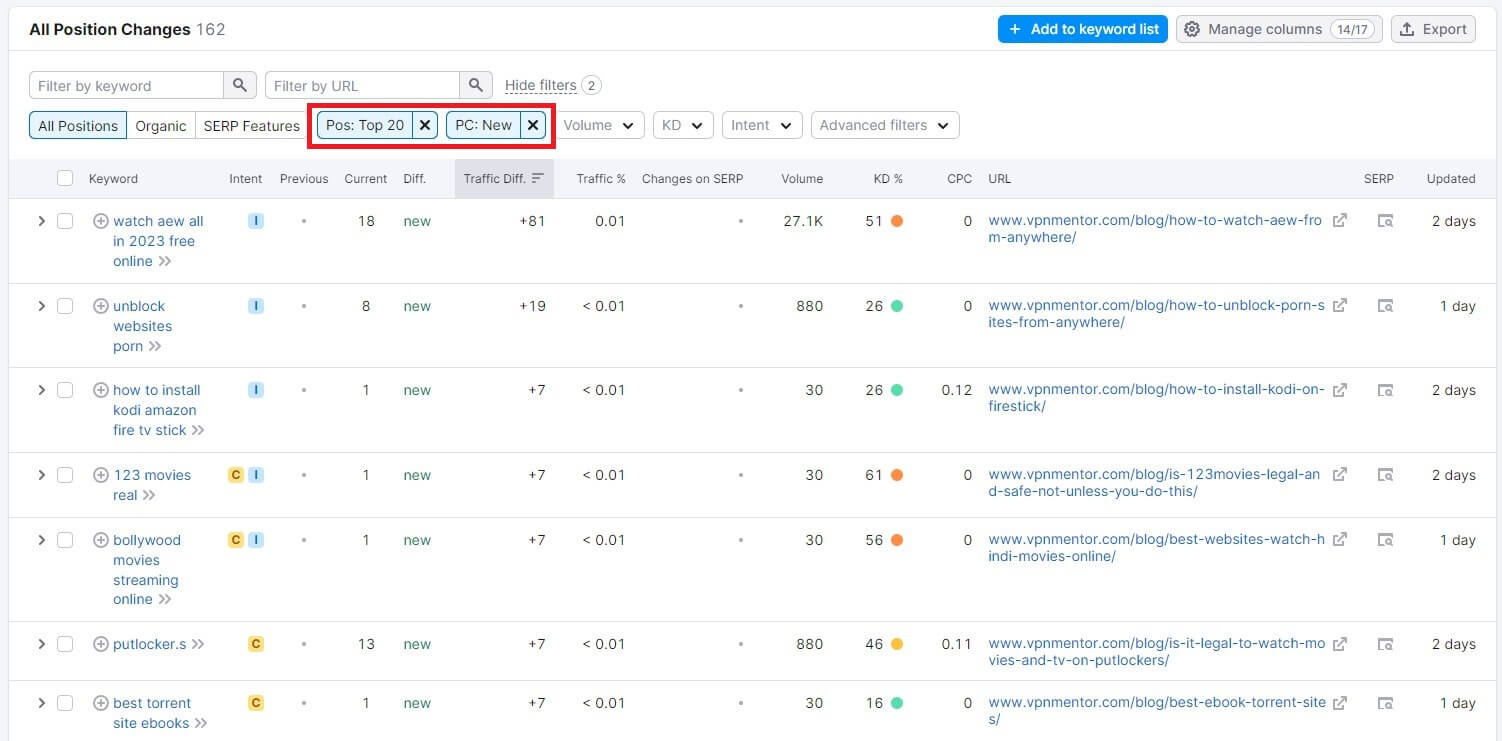
However, this time, instead of Lost, choose New under the Position Changes menu, while keeping the Top 20 Positions filter. You can use these keywords as an indication of which direction to go and which content to aim for to improve your rankings on Google.
Find Lost and New Keywords With Semrush
Analyze Competitor’s Content
It’s time to analyze the content of your rivals more thoroughly. Content is the KING because its quality determines your ranking. Low-quality content means your ranking probability is lower and vice versa. To analyze your competitors’ content, you can start with Organic Research.
Content Variety
Again, provide the tool with the domain URL and Semrush will come up with the best-performing pages. You’ll see the amount of traffic they get, with their URLs where you can directly access them. Carefully examine each page.
Are the best-ranking pages long-form content? What do they contain? Are there plenty of visuals like videos, images, infographics, and so on? If so, then it’s a good idea to follow in the same or at least similar footsteps because that’s the content readers like.
Beware that including photos and videos should be followed by proper optimization. Too large files can increase page-loading times, boosting the bounce rate simultaneously. If you’re going in this direction, compress your images and videos before uploading them.
You can then use PageSpeed Insights from Google to see how fast your website performs.
Content Quality
When it comes to content quality, an SEO competitor analysis can be performed manually. Again, grab some of the competitor’s highest-ranking articles and check their quality. By that, we mean the accuracy of the provided data, grammar, and helpfulness.
If all of the above is fulfilled, this is one of the competitor’s strengths. Another smart thing is to check for keyword stuffing, outdated content, and a so-called tex-to-image ratio. Text should be present way more than images for a great user experience.
However, if we’re discussing high-ranking pages, chances are their quality is excellent, which means you can use them as inspiration for potential improvements. However, if you find a poorly optimized page with thin content, you could capitalize on that.
Create a page that covers the subject, optimize it better, and overtake the competitor! Improve upon its readability and focus on concise and easy-to-digest information distribution. If the content you analyzed is 10/10… well, think about something even better and try your luck.
Meta Description & Titles
Many overlook the importance of meta titles and descriptions. Wrongfully so. They dictate how the page will look in SERPs, as these two are the main things that show up in the search results.
Don’t believe us? Well, do a quick search on Google!

The highest-ranking pages should serve as a benchmark of how your meta titles/descriptions should look like. Remember – this can increase your CTR if done well. Your competitors might be better in this regard, hence their higher ranking.
Think about your meta descriptions and titles when doing a competitor SEO analysis. Are they creative and attention-attracting? If not, look at the highest-ranking pages of your competitors and see what they do well and what you don’t.
Make sure you include the main keyword in your meta titles and descriptions. Also, ensure they’re placed at the front and that the meta title/description is… well, descriptive. Think about what would make YOU click on a specific search result and go with that.
Featured Snippets
Featured snippets are among the most powerful CTR boosters. They look like this:
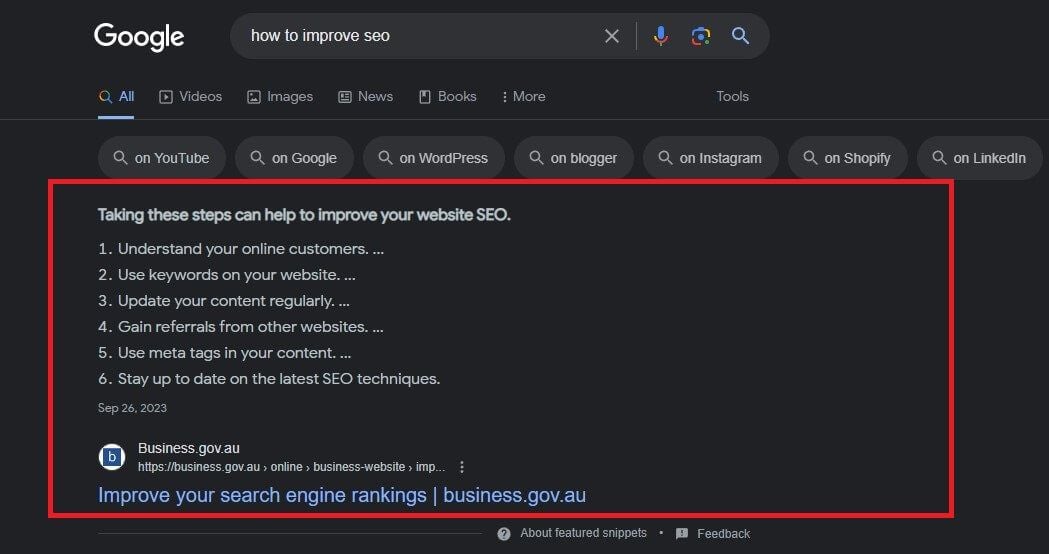
Being so significant, they appear at the top of SERPs above all organic results. They can be text-based, list-based, and with some images/video attachments. You can find out more about your competitors’ featured snippets by using Semrush’s Organic Research.
Why would you do that? To understand what they did to make it there. Most likely, they’ve covered the topic thoroughly, answering the given questions concisely and accurately. Maybe it’s in an FAQ section or some of the main paragraphs.
Nevertheless, open Organic Research and type in the domain address. Scroll down and find SERP Features. Select the “Featured Snippet” option and Semrush will list every feature snippet the given competitor has, along with the key phrase and URL of that page.
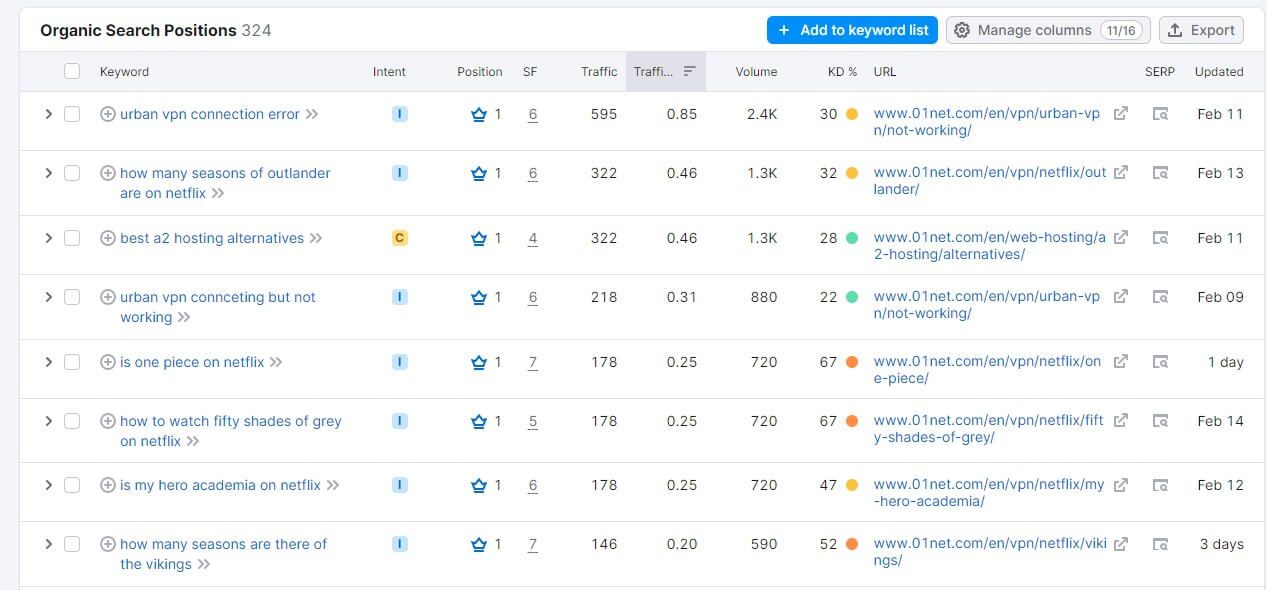
Now, give this page a good read and try to figure out its qualities. You can implement the same qualities and improvements and hopefully, end up in a featured snippet. This SERP feature is so powerful, that it can outperform a higher-ranking page that’s not in the featured snippet. Don’t miss out on this great opportunity!
Discover Competitor’s Backlinks
Your higher-ranking competitors likely have a myriad of quality backlinks. To perform an in-depth SEO competitor analysis, you’ll need to take this into account. What are backlinks? These are the links that lead from one site to another – think of them as recommendations.
Do you see why they’re important now? The more backlinks the domain has, the more authoritative it is, hence the higher ranking in SERPs and everything else. You can again use Semrush and its Backlink Analytics tool. Provide your domain address and press Analyze.
When analyzing the domain, you’ll get info about referring domains, total backlinks, and monthly visits. You can add another competitor (or up to 4 in total) and compare their backlink profiles to see why the competitor is better (or it isn’t?!).
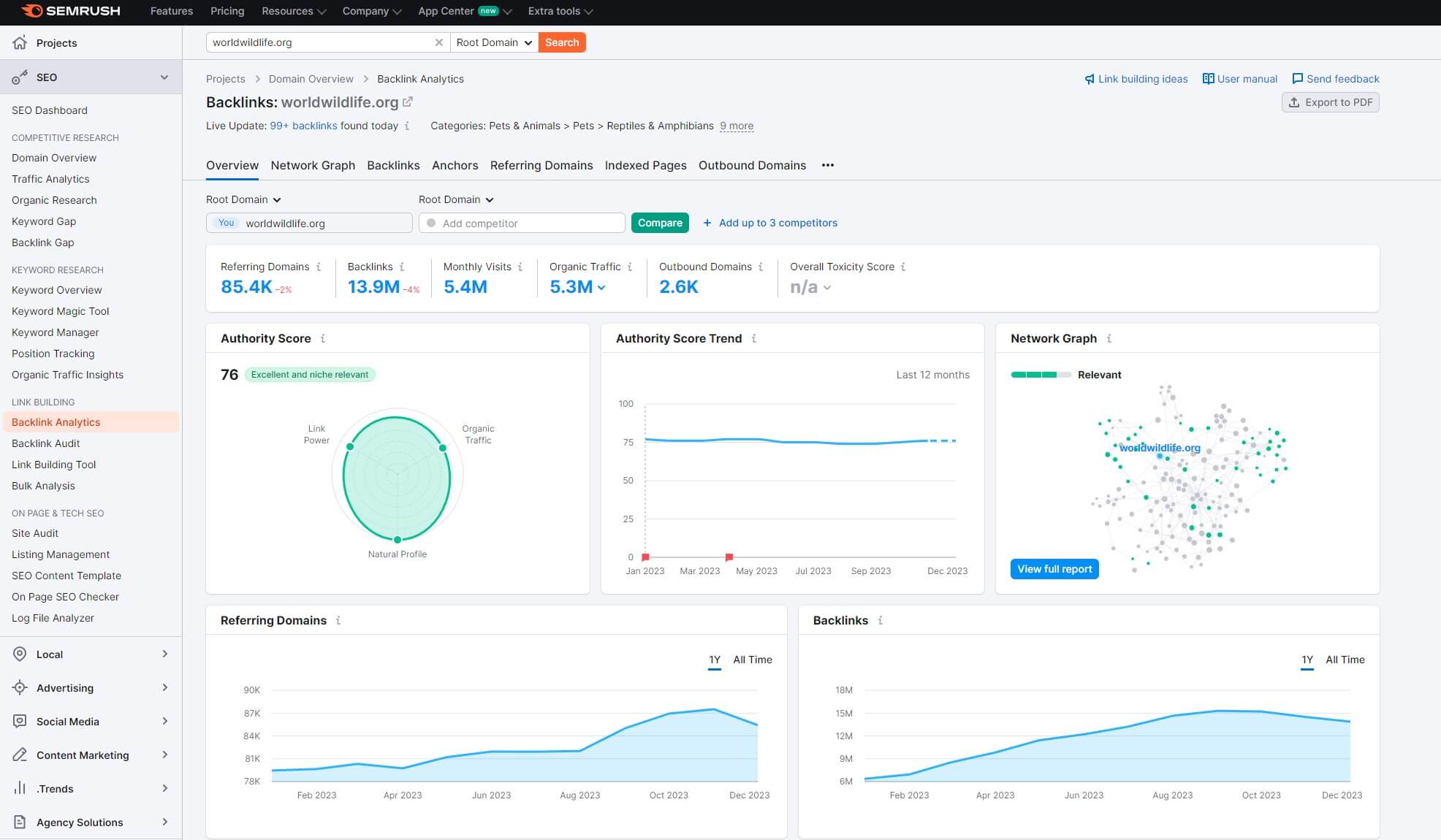
When looking at referring domains, check their authority score because not all backlinks are quality, especially if they come from shady sites with a low AS (authority score). In the Backlinks tab under Backlink Analytics, you can discover various types of backlinks.
Analyze Follow and Nofollow links and see if the competitors’ backlink profiles are “natural.” You can also view lost backlinks and see if they came from credible sites – you can capitalize on that as well. In Semrush, you’ll find the link-building tool as well.
Using it, you can reach websites directly and contact them through email for a backlink or guest post. However, it’s better to do so after you perform a backlink gap analysis.
Analyze Competitors’ Backlinks With Semrush
Detect Backlink Gaps
Backlink gaps are the same as keyword gaps but in the backlink world. This function detects which websites link to your competitor but not you, and again, you can compare your domain with up to 4 others. Open Backlink Gap in Semrush and do that.
When you detect referring domains that aren’t linking to you, analyze their authority scores and monthly visits. You can also click on referring domains where you’ll find links to your competitors’ pages. Analyze these pages and see what they offer.
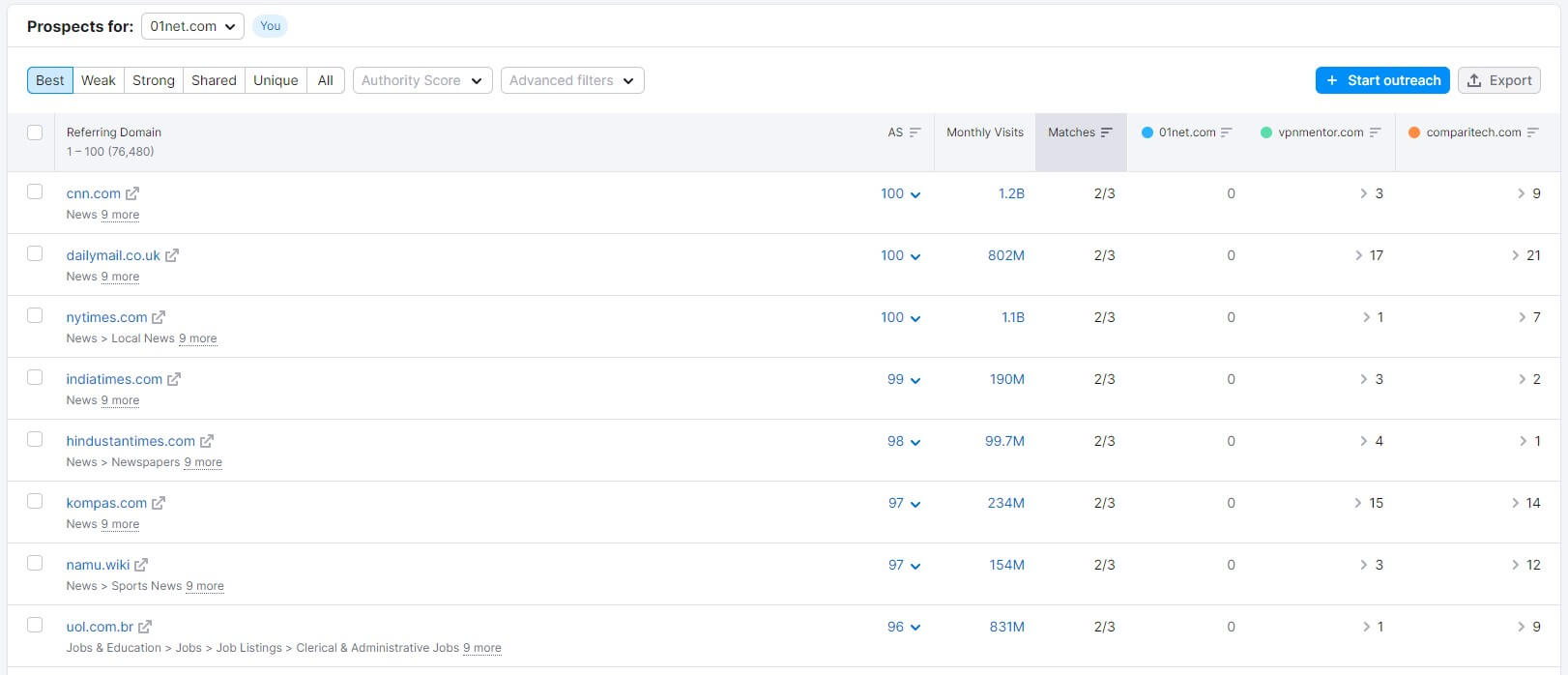
If you don’t have anything similar on your site, focus on providing the same content but with better information and quality. You can then use the aforementioned link-building tool to contact websites directly and ask for a backlink to rival your competitors.
Perform a Technical SEO Audit
The last thing we want to mention in an SEO competitor analysis is a technical SEO audit. Performing a site audit is simple with Semrush, as there’s a dedicated Site Audit function. You can audit your site or competitor’s – doesn’t matter.
What matters is the discovery of specific parameters and comparing them to your competitors. We recommend auditing your site first and then moving on to your organic competitors discovered at the start of an SEO competitor analysis.
Look for things like:
- User experience
- Website performance
- URL structure
- Mobile-friendliness
- Markup
If the competitor’s domain has better performance and user experience, you need to improve yours. Semrush will display Core Web Vitals, which is a good indicator of performance and responsiveness.
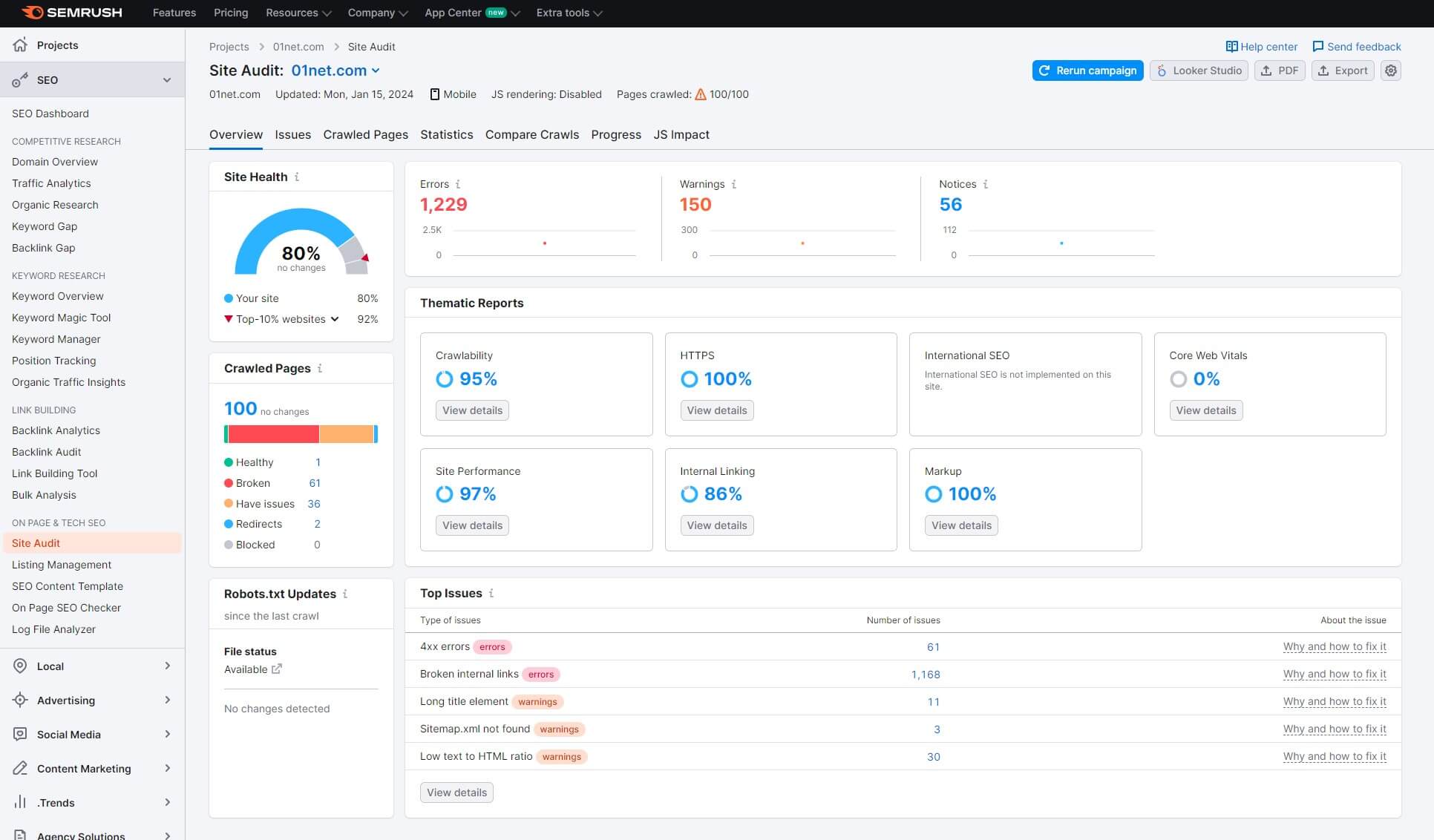
This is why you should optimize and compress images and videos on the page. The URL structure should be impeccable. It should include the given keyword but also provide the context of the article to allow the visitor to see what it’s about.
Mobile-friendliness is also paramount because of Google’s Mobile-First Index. This means Google will first analyze the mobile version of your site before ranking it. If it’s unsuitable for small screens, good luck ranking higher. We analyzed this metric in many of our rivals.
Guess what? All sites ranking higher than ours have exquisite mobile versions! For this SEO competitor analysis, you can use GSC and find the Mobile Friendliness test in the left-hand side menu. Google will tell you if the site is mobile-friendly and if it’s not, it’ll tell you what to fix to make it suitable.
Schema markup helps the search engine understand the page content and rank it. You’ll find the Schema Markup parameter in Semrush, where it can assign a score from 0 to 100. Having proper schema markup is crucial for Google and other search engines.
You can improve your schema markup to utilize rich snippets and make your SERP appearance more appealing.
Measure Competitors’ Site Performance With Semrush
On-Page SEO
Are you looking to outrank your competitor for a specific page? In that case, perform an SEO competitor analysis on it by using Semrush’s On-Page SEO Checker. It does the same as the Site Audit tool but focuses on individual pages.
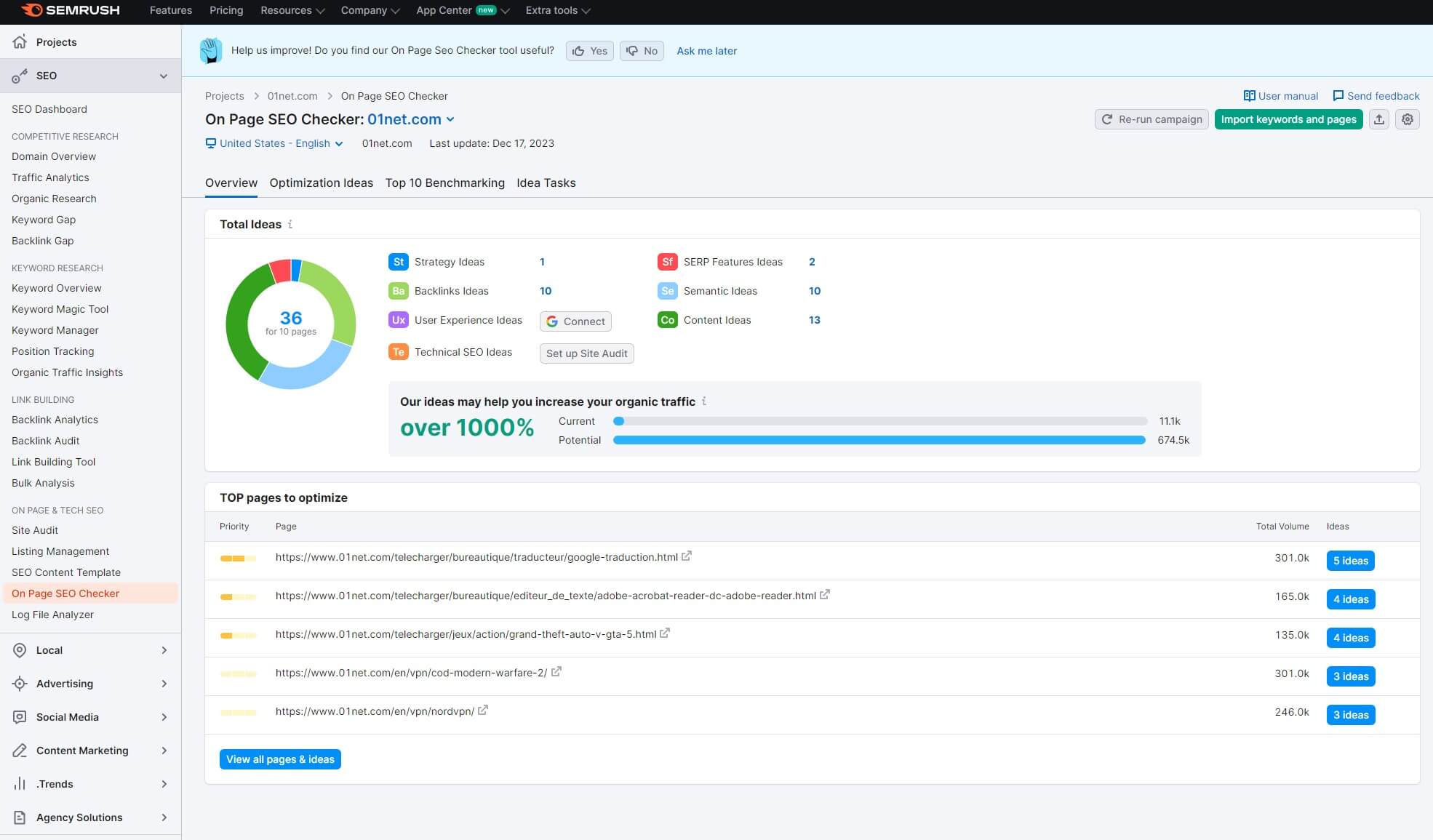
This will aid in the discovery of the competitor’s weak points and aspects that need improving. Semrush will come up with optimization ideas that you can implement to rank the page higher for a particular keyword.
Be sure to compare pages on the same topic and for identical ranking keywords. This will allow you to directly compete with the rivals and “attack” them head-on through better content quality, superior optimization, or a higher readability score.
Best Tools for an SEO Competitor Analysis in 2025
Before we wrap up the guide, we should promptly go over our favorite SEO competitor analysis tools. In this article, we focused on Semrush because it has everything you need for this purpose. You don’t need any third-party options, except for Google Search Console, which can analyze a few parameters that Semrush can’t.
Other than that, we also love SE Ranking. It’s the closest rival to Semrush, offering amazing features for less money. SE Ranking lacks backlink audits but it offers everything else, including competitive research, keyword research, site audits, and an AI writer that can improve your readability and overall quality.
We should also quickly mention Ahrefs as a respectable option. It has many amazing tools, including Site Explorer that can be used to analyze your competition. You can fetch information about the site’s backlink profile, paid traffic, and organic traffic very easily.
Ahrefs will display the top pages of your competitor and provide more data about domain ratings, external/internal links, and much more. It’s good to know that Ahrefs also includes free SEO tools great if you don’t want to pay a rather expensive asking price.
Finally, you can also use Moz whose pricing is affordable, while the software is inferior to SE Ranking and Semrush. However, this tool comes with valuable metrics about the authority score, keyword difficulty, search volume, and daily rank tracking.
In Summary
In conclusion, performing an SEO competitor analysis is key to discovering your position in the market. It helps you know where you are, where you should be heading, and how to fulfill your goals amidst the fierce competition.
We strongly recommend using Semrush to find everything you need. Its Organic Research will identify your competitors, find their strengths/weaknesses, and display the authority scores of your rivals. You can also use its backlink and keyword gap tools.
With the discovery of your competitors’ ranking keywords and backlinks, you can improve upon these major SEO parameters. Google Search Console helps analyze the site’s mobile-friendliness and Core Web VItals.
By implementing these tools and carefully examining your competition, we guarantee you’ll be able to prosper. Don’t forget about Semrush’s 14-day trial and a 7-day refund policy that you can enjoy through our site and perform several SEO competitor analyses for free.
In the meantime, you can also check our SE Ranking review if you see it as a superior SEO competitive analysis tool for you.